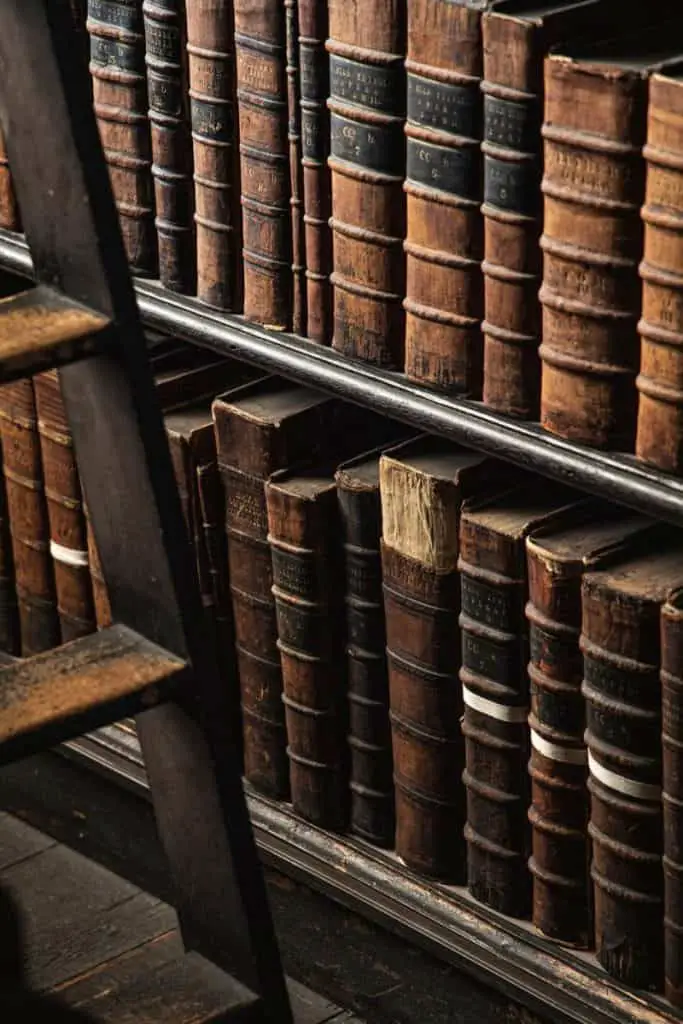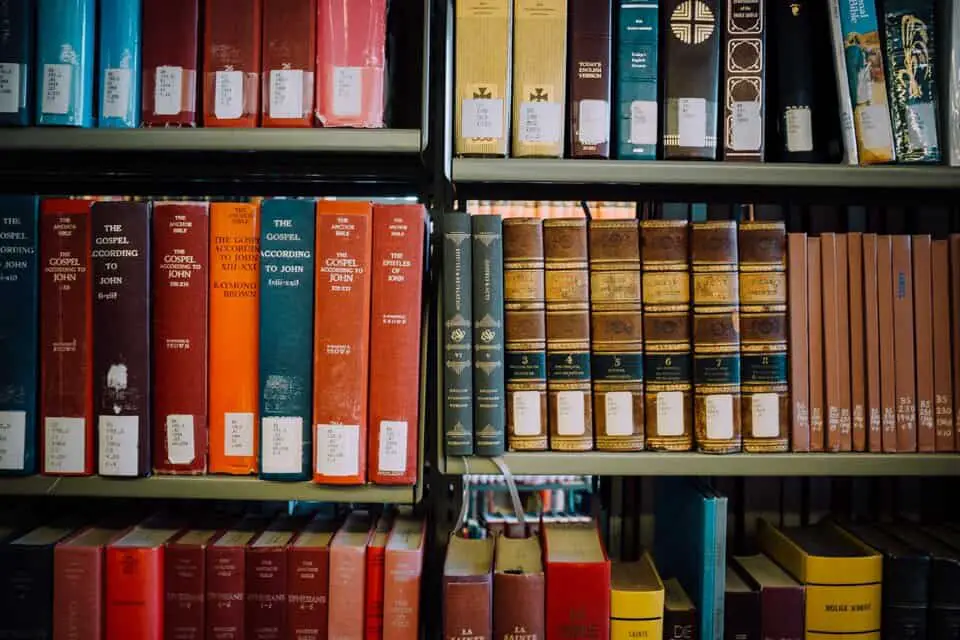I grew up in a home where two 10-foot tall bookcases made of dark mahogany always took up a corner of the living room or office. These majestic book cases were perfect for putting virtually anything on display, but not everyone has a family heirloom from a family lumber business with over 9 decades of history. So for the rest of us, finding the perfect bookcases for antique books will take some searching and effort.
The good news is that there are plenty of options out there because people who love good furniture, good antique books, and good ways to display them safely. There are some shelves that only deal with one or two of these concerns, but there are options that take care of all of them. On a related note there is also always going to be a good appreciation of great woodwork, so there are good options when it comes to finding a good bookcase that actually meets your needs.
But how do you find the one that meets all of your needs and keeps your collection safe?
Let’s dive in on this topic and find out!

What Are the Best Bookcases for Antique Books?
There are answers to this based on what technically is best overall for storage with limited very long term damage (the kind that sometimes takes decades to show) versus what looks good and displays well.
In other words, there are many considerations to put into play before making a final decision on what type of shelving works best, and we need to dive into how to take all these considerations together to find the perfect shelf to display your favorite book collection.
Aesthetics
One of the major ones for me is aesthetics. A good bookshelf is a great piece of furniture, period, but if you are looking for good bookcases for an antique or collectible book collection you take pride in, then you’re going to want to show them off or at the very least, admire them.
That’s much easier to do on treated mahogany or a dark stained wood book shelf than it is bare metal shelving. The former pulls together that feeling of elegance and sophistication while the latter is clashing from an aesthetic standpoint, no matter how much it might make sense from the standpoint of keeping the book in a safe and optimal condition.
Also keep in mind your living space. I love the dark mahogany wood book shelves we grew up with, but I also lived in rural country houses that often had a rustic or country look. How would those look in an all-white, clean, ultra modern urban home?
Probably weird and as garish as good wood shelves can look when they’re that out of place. It’s like the problem of picking out a couch, electronics, or paint in a store – it’s in a vacuum with how it looks. Take pictures of your home space on your smartphone so you can imagine what the thing in front of you looks like in the actual context of your home where it will be.
The same applies for matching the aesthetics of your
The overall look is important when picking out book shelve whether old or new, and while it shouldn’t be the only factor, not having it as one of the highest factors would be foolish.
Safe For The Books
Because I understand that even with properly treated and sealed wood, over enough decades there are chemical interactions between books on the shelf and the shelf itself at the molecular level.
I don’t understand the science beyond that, but you leave books untouched on a shelf for 50 years and it will not be in the same exact shape and condition as when you put them on.
However, as covered in previous articles on display options for antique books, we’re not settling for metal shelves. While that might be the science answer for best option, it’s not aesthetically pleasing and that really does a disservice to the beauty of the amazing antique books, vintage collectibles, and rare first printings that you want to put on display.

While I can appreciate that when you’re looking at old oils, acids, all the potential reactors in a wood shelf or paper in an antique book, it doesn’t change the fact that metal just isn’t the most “show off” option out there. I’m a huge fan of really good looking wood shelves and in fairness, when properly treated or with the right additional buffering, this can work.
For example, thin glass layering over the wood itself. This keeps the stunning good look of the wood shelves and the antique books while setting things up in a way to avoid books from making direct contact with wood. This is important because on a molecular level oils and chemicals in the wood, paper, and book cover materials can result in long-term stains, yellowing, or damage.
Granted, over time can mean years or even decades until any of it is noticeable, but if you really treasure your books then why would you settle for any damage at all? Especially when it’s all preventable.
That is why the glass covering over treated word is a legitimate option, and one that I definitely think looks better than faux wood, even though good faux wood is much better than it used to be. Still, nothing beats a truly beautifully crafted wood book shelf.
Size of the Shelves Themselves
Size matters. While my Dad owns beautiful 10 feet tall solid mahogany book shelves that have been the family for nearly a century now…they are heavy. Extremely heavy. Hard to move. And those shelves are set. There is no extra room for moving shelves or optimizing space.
But in a full sized house you’ll be living in for years or even decades: they’re beautiful, eye-catching, and the perfect way to display a certain number of books.
If you’re still living the apartment life, or live in a smaller simpler dwelling like a cabin, a yurt, or you like your house to be small and cozy, then smaller shelves that are easier to move and fit in with the look of your house makes a lot more sense. Fitting the book shelves to your living area is
However, depending on the type of vintage books that you have or are putting on display, standing vertically on a normal shelf might not be the ideal setup, especially with unconventional sized books, though a customized option in that particular case can work. This is all about the situation with your books and the setup of your living area.
What Makes a Good Book Shelf for Antique Books?
Good display matters, but at the same time you also want everything in a room to match with everything else. Ever try putting old school wood bookshelves in a modern office? Or a piece of modern furniture in an old school study?
It just doesn’t work. Not only does the appearance look terrible, but styles tend to have a degree of functionality built in and throwing a curveball into that setup can make the actual functionality of that area suffer as a result.
There isn’t necessarily a long list of specific design parameters for this, but there are some details all good shelves will have in common.
- Smooth treated wood – there can’t be any rough edges and everything should have long since been planed
- No recent stain treatments (chemical reactions at a molecular level is something you don’t want)
- Will look good aesthetically, be nice on the eyes
- Fits in with your living area – fits in with the rest of the decor in the room it will be in
- Uses hardwood for construction versus softwood or plywood
These are very basic parameters, but they are pretty necessary if you want to end up with the type of book shelves that can properly display antique books, add to the most common aesthetic you would associate with the types of book shelves that hold antique or collectible books.
After those basic parameters are met the biggest question comes to one thing: the type of wood used to build those bookshelves. Because as any self-respected collector will tell you, or anyone with really good taste, wood book shelves are the best!
What Wood Makes for the Best Book Shelves?
This is a complicated question because there are many different factors that go into answering it. The focus will be on the solid materials that aren’t known for having a lot of issues with oils or molecular interactions, for best overall appearance based on common taste, and also durability.
A shelf made from strong hardwood that is properly taken care of can last not only decades, but even become a century or multi-century old heirloom.
So what types of wood are ideal for the finest bookshelves worthy of safely and effectively storing (and displaying) wonderful vintage books?
If money is no object the best wood choices for book shelves, or any other pure wood furniture, are:
- Mahogany (there’s a reason this is just the classic “upper class” lumber used for high end wood work)
- African Padauk
- Teak
- Koa
If budget does matter but you still want quality the best wood choices are:
- Oak
- Walnut
- Cherry
- Cedar
These are much more common than the top ones on this list, and can make for fantastic book shelves. Another advantage of this is that you can get a whole home set of furniture all in oak or all in walnut while it’s much harder to do something like that with Teak or Koa.
That doesn’t mean that book shelves made out of other lumber can’t do well, but those are the ones that really stick out. There are some pros and cons with each, but something like teak where the huge challenge is the dulling of tools is the woodworker’s problem, not the buyer!
Make sure any wood shelves are treated and not just with a planer for smoothness. You want to make sure the shelves are treated in such a way that the books, or anything else you choose to display on them, won’t receive damage from aging.
If you want some stunningly good looking book shelves that are perfect for displaying your vintage book collection, going with one of the above options will give you the long-lasting look and support that you want!
Finding Your Perfect Book Shelves: The Final Verdict
When it comes to finding the perfect bookcase for displaying your antique book collection, it can take a bit of work. You not only need the right type of shelves to properly display them, but the types of antique books that are best stored in that manner. You also need appropriately sized shelves and of course it’s always best to have shelves that fit the general aesthetic of your domicile.
While I love those book shelves that my siblings and I grew up seeing in the living room, those would not fit in most apartments, much less fit the look of them. Because of that the wouldn’t be the best choice for many layouts of places where I’ve lived.
By understanding the basics of how old books need to be stored and taken care of and the construction of shelves in a way that allow that without giving up aesthetics by going the metal route, you can pick out the perfect shelves for your books.
Other Antique Book Articles of Interest
